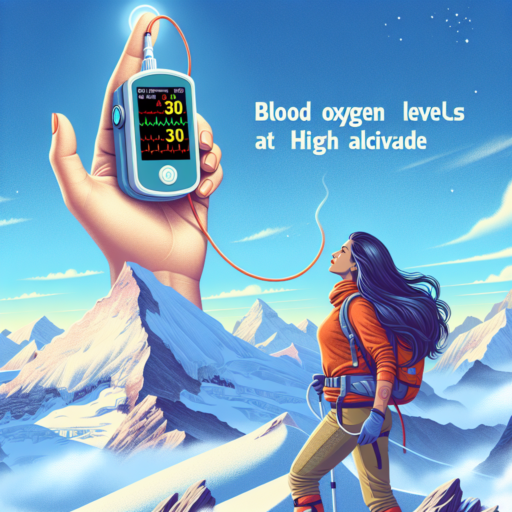What is a good blood oxygen level at high altitude?
Understanding what constitutes a good blood oxygen level at high altitudes is critical for maintaining optimal health and performance during such conditions. At sea level, normal blood oxygen saturation levels range from 95% to 100%. However, as altitude increases, oxygen levels in the environment decrease, leading to lower blood oxygen levels in the body.
At higher altitudes, a good blood oxygen level is generally considered to be between 90% to 95%. This range indicates that your body is adapting well to the reduced oxygen levels found in high-altitude environments. It’s important to note that individuals may experience varying degrees of adaptation, and what works as an ideal level for one person may not be the same for another.
Adapting to high altitudes and maintaining a good oxygen saturation level can be supported through gradual acclimatization. This process allows your body to slowly adjust to the lower oxygen levels without experiencing adverse health effects. Monitoring blood oxygen levels with a pulse oximeter can provide valuable feedback on how well your body is adjusting and whether additional acclimatization is needed.
What is a dangerously low oxygen level?
Understanding what constitutes a dangerously low oxygen level is critical for maintaining optimal health and preventing potential life-threatening conditions. Generally, a healthy oxygen saturation level, often measured with a pulse oximeter, should range between 95% to 100%. When these levels drop below 90%, it is considered hypoxemia, a deficiency in oxygen in the bloodstream, which triggers a state of alarm for immediate action.
Various symptoms indicate a drop in oxygen level that individuals should be vigilant of. Experiencing difficulty breathing, severe headache, confusion, bluish coloration in the face, lips, and nails, are clear signs of inadequate oxygenation. These symptoms necessitate urgent medical attention to prevent more severe health issues, including risk for heart and brain damage.
It is essential to understand the underlying conditions that might lead to a dangerously low oxygen level. Diseases like chronic obstructive pulmonary disease (COPD), asthma, heart disease, and sleep apnea can severely impair the body’s ability to absorb oxygen efficiently. Continuous monitoring and medical management are vital to ensuring oxygen levels remain within a healthy range to avoid spiraling into critical health scenarios.
How much less oxygen is there at 8000 feet?
At an elevation of 8000 feet above sea level, the atmosphere experiences a significant decrease in oxygen availability. It’s important to understand that the percentage of oxygen in the air remains roughly the same, about 21%, no matter the altitude. However, the air pressure at 8000 feet is much lower than at sea level. This reduction in air pressure causes the oxygen molecules to spread out more, meaning there are fewer oxygen molecules in any given lungful of air compared to at sea level.
At 8000 feet, the body must adapt to having roughly 25% less oxygen available for each breath. This can lead to a condition known as hypoxia, where not enough oxygen reaches the tissues of the body. The severity of the symptoms can vary, but it’s the reduced pressure — not the change in oxygen concentration — that drives this decrease in oxygen availability. Adjusting to this drop in oxygen can be challenging for individuals who are not acclimated to higher altitudes.
The impact of this reduced-oxygen environment is that bodily functions have to work harder to obtain the oxygen they require. Activities that are normally performed easily at sea level might demand more effort and cause increased fatigue at higher elevations. Although the body can adapt to these conditions through a process known as acclimatization, this adaptation requires time spent at the elevated altitude to adjust to the decreased oxygen levels.
Is an oxygen level of 92 good to fly?
Traveling by air can entail sitting in pressurized cabins which, despite being designed to approximate sea level conditions, can affect oxygen saturation levels in the body. This raises an important question for passengers concerning their health: Is an oxygen level of 92 good to fly? Understanding the implications of this can help ensure a safe and comfortable journey.
Normally, a healthy individual’s oxygen saturation level typically ranges from 95% to 100%. However, the conditions in an airplane cabin can cause these levels to dip. A reading of 92% is slightly below the normal range, raising concerns about the adequacy of oxygen for efficient bodily function during a flight. It’s crucial to note that for individuals with chronic respiratory issues or heart problems, even a small decrease in oxygen saturation can be concerning.
If you’re considering flying with an oxygen level of 92%, consulting with a healthcare professional is advisable. They can assess whether supplemental oxygen or other interventions may be necessary for you during your flight. Additionally, engaging in activities to increase oxygen levels, such as deep breathing exercises, can be beneficial before and during the trip.
For travelers with underlying health conditions, or those feeling uneasy about their oxygen levels, it’s essential to consider the altitude of your flight and its duration. Longer flights at higher altitudes may exacerbate the drop in oxygen saturation, making it more challenging for your body to adapt. In such scenarios, taking proactive steps under medical guidance can mitigate potential risks and ensure your well-being throughout your journey.










